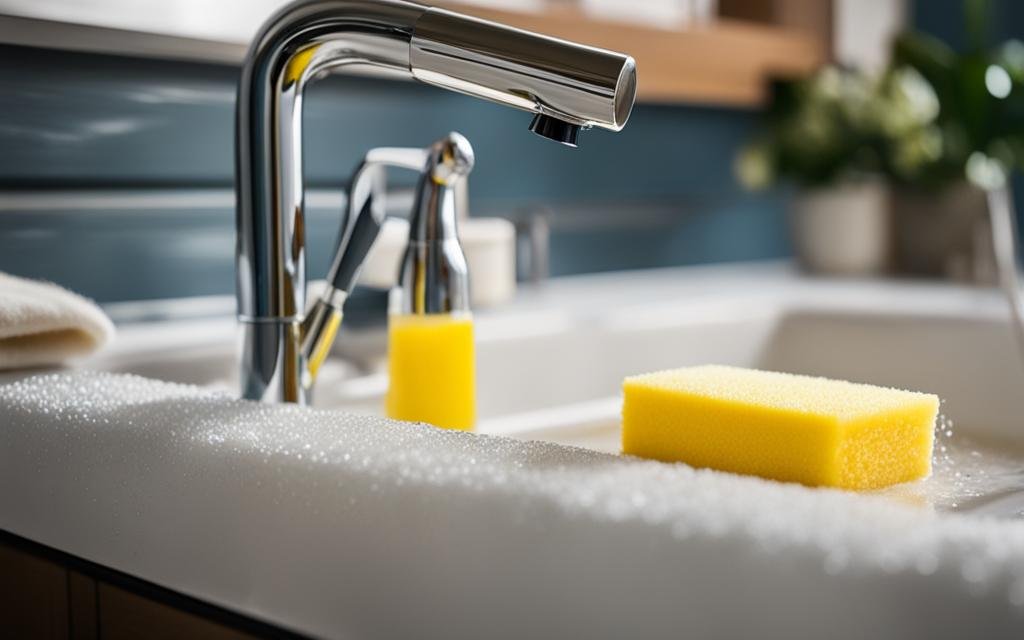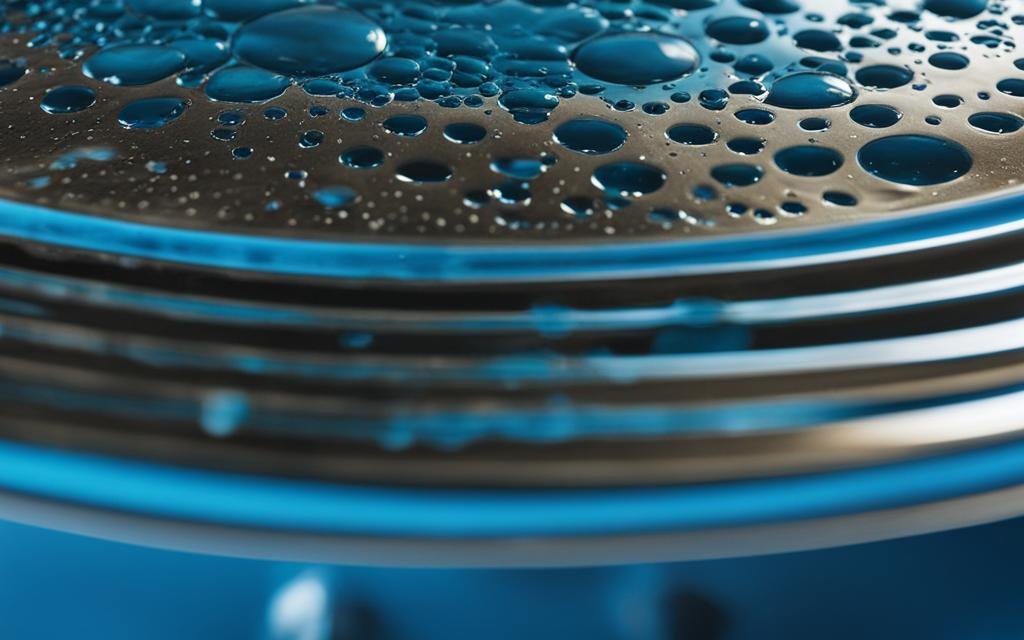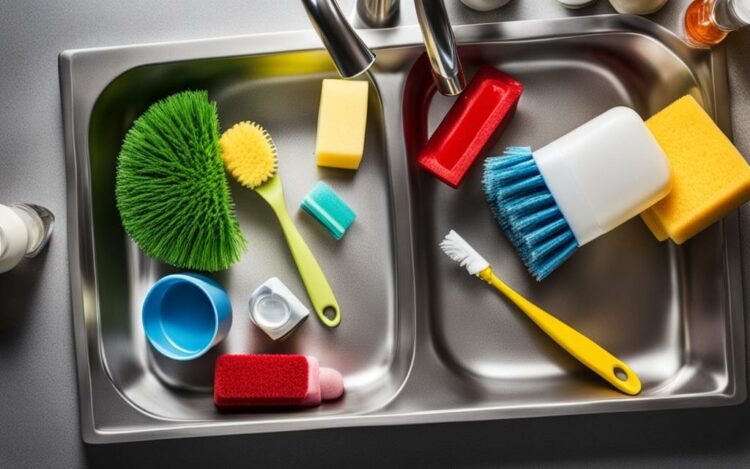Taking care of your kitchen sink is essential to ensure its longevity and protect your investment. By following proper maintenance guidelines and implementing a few key tips, you can extend the lifespan of your sink and keep it in top condition for years to come.
Key Takeaways:
- Regularly clean your sink and use mild soap to scrub away stains and dirt.
- Pay special attention to the faucet area and use a toothbrush for thorough cleaning.
- Maintain a clean faucet by removing soap scum and dirt with a cleaning solution.
- Consider using a vinegar solution to remove hard water spots on your faucet.
- Remove sediment from your garbage disposal using methods like ice cubes or vinegar.
Cleaning Your Sink
Maintaining a clean and hygienic sink is essential to ensure its longevity and keep it looking pristine. Regular cleaning not only removes stains and dirt buildup but also prevents the growth of bacteria and unpleasant odors. Follow these tips to effectively clean your sink:
- Wipe down the surface: Use a soft cloth or sponge to wipe down the surface of the sink, removing any loose debris or food particles.
- Scrub away stains: For stubborn stains or dirt, use a mild soap and circular motions to scrub the affected area. This will help break down the stains and remove any grime.
- Pay attention to the drain area: The drain area can accumulate residue and become a breeding ground for bacteria. Use a toothbrush or small brush to clean around the drain and remove any buildup.
Additional Tips:
- Use baking soda and vinegar: For a natural and effective cleaning solution, mix baking soda and vinegar to form a paste. Apply the paste to the sink surface and scrub gently with a sponge or brush.
- Avoid harsh chemicals: Harsh cleaning chemicals can damage the surface of your sink. Opt for mild soaps or natural cleaning solutions to protect the integrity of the material.
- Dry thoroughly: After cleaning, make sure to dry the sink thoroughly to prevent water spots and mineral buildup.
- Renovating your Kitchen? Explore The RTAStore discount code for discounted rates on premium Kitchen essentials.
By incorporating these cleaning tips into your sink maintenance routine, you can maintain its cleanliness, remove stains, and prevent dirt buildup, ensuring that your sink stays in excellent condition for years to come.

Cleaning Your Faucet
Maintaining a clean faucet is essential for both functionality and aesthetics. Over time, soap scum, dirt particles, and other debris can accumulate on your faucet, affecting its performance and appearance. By following a few simple cleaning steps, you can keep your faucet looking sparkling clean and free from buildup.
Remove Soap Scum and Dirt Particles
- Start by dampening a soft cloth or paper towel with warm water.
- Gently wipe down the entire surface of the faucet, including the handles and spout, to remove any loose dirt or residue.
- If the faucet has stubborn soap scum or dirt, create a vinegar solution by mixing equal parts white vinegar and water.
- Apply the vinegar solution to the cloth or paper towel and carefully scrub the affected areas, using circular motions.
- Rinse the faucet thoroughly with warm water to remove any remaining vinegar residue.
Clean the Aerator
The aerator is a small mesh screen located at the end of the faucet spout. It helps regulate water flow and prevent splashing. Over time, the aerator can become clogged with mineral deposits, affecting water pressure. Regular cleaning is crucial to maintain optimal performance.
- Remove the aerator by twisting it counterclockwise. Use a pair of pliers if it’s difficult to unscrew.
- Soak the aerator in a bowl of white vinegar for about 30 minutes. This will help dissolve any mineral deposits.
- Gently scrub the aerator with an old toothbrush to remove any remaining debris.
- Rinse the aerator with water and reattach it to the faucet by twisting it clockwise.
By incorporating these cleaning techniques into your regular maintenance routine, you can keep your faucet spotless, free from soap scum, dirt particles, and mineral buildup. Remember to always follow the manufacturer’s guidelines and avoid using abrasive cleaners or scrub brushes that could scratch the faucet’s surface.
Removing Sediment From Your Garbage Disposal
If you want to keep your garbage disposal running smoothly and prevent clogs and foul odors, it’s essential to remove sediment regularly. There are several effective methods you can use to accomplish this.
Ice Cube Method
- Drop a few ice cubes into your garbage disposal.
- Run the disposal for about 30 seconds.
- The ice cubes will help break down and loosen any built-up sediment.
- Once done, run cold water through the disposal to flush away the residue.
Vinegar Method
- Pour half a cup of vinegar down the drain.
- Let it sit for about 10-15 minutes to allow the vinegar to dissolve the sediment.
- Run cold water through the disposal to flush away the loosened residue.
Hot Water Method
- Boil a kettle or pot of water.
- Pour the hot water down the drain while the disposal is running.
- The hot water will help melt away any residue or sediment.
- Continue running cold water through the disposal to flush away the debris.
By incorporating these methods into your garbage disposal maintenance routine, you can effectively remove sediment and keep your disposal functioning optimally. Remember to always exercise caution when working with your garbage disposal and only use these methods as instructed.
Rejuvenating Your Drain
If you’ve noticed a slow drain in your sink, it’s essential to address it promptly to prevent further issues. A clogged drain can lead to unpleasant odors and even potential water damage. To tackle this problem, there are several effective methods you can try.
1. Use a Drain Cleaner
A drain cleaner is a quick and convenient way to clear out blockages and restore proper drainage. Look for a drain cleaner that is specifically formulated to dissolve common clogs like hair, grease, and soap scum. Follow the instructions on the product and be sure to use it in a well-ventilated area.
2. Prevent Future Clogs
Prevention is key when it comes to maintaining a healthy drain. Use non-clogging soap and avoid pouring grease or oil down the drain. Additionally, you can periodically use a vinegar and baking soda combination to keep your drains clean and odor-free. Simply pour half a cup of baking soda down the drain, followed by half a cup of vinegar. Let the mixture sit for a few minutes, then flush it out with hot water.
3. Consider Using a Snake or Auger
If you’re facing more severe blockages in your drainpipe, a snake or auger can be a valuable tool. These tools are designed to break up and remove stubborn clogs that may be out of reach from a traditional drain cleaner. Use a snake or auger according to the manufacturer’s instructions, and be cautious not to damage your pipes.
By regularly maintaining your drain and addressing slow drains promptly, you can ensure your sink functions properly and prevent further complications. Remember, if you’re unsure about handling a complex blockage or if your efforts don’t yield the desired results, it’s always best to seek professional plumbing assistance.

Kitchen Sink Maintenance: Tips to Extend the Lifespan of Your Investment
Proper maintenance and care are crucial for extending the lifespan of your kitchen sink and protecting your investment. One effective way to prevent hard water stains and preserve the appearance of your sink is by installing a water-softener. Hard water stains can be stubborn and difficult to remove, but with a water-softener, you can minimize the potential for these stains to occur in the first place.
When considering the installation of a water-softener, it is important to seek the services of an experienced plumber. They have the knowledge and expertise to properly install the water-softener system, ensuring it functions efficiently. An experienced plumber will also be able to recommend the right type and size of water-softener for your specific needs.
Benefits of Installing a Water-Softener:
- Prevents hard water stains: The primary benefit of a water-softener is its ability to prevent hard water stains from forming on your sink. Hard water contains minerals that can leave unsightly deposits and make your sink look dull and dirty. Installing a water-softener will help reduce the mineral content in the water, keeping your sink stain-free.
- Prolongs the life of your sink: Hard water stains not only affect the appearance of your sink but can also lead to corrosion and damage over time. By preventing the buildup of these stains, a water-softener helps prolong the lifespan of your sink, saving you from costly repairs or replacements.
- Improves water quality: In addition to preventing hard water stains, a water-softener also improves the overall quality of your water. Softened water feels better on your skin and hair, lathers easily with soap, and reduces the need for excessive detergent use when washing dishes or clothes.
Investing in a water-softener for your sink is a wise decision that will not only enhance the appearance of your sink but also protect its longevity. By preventing hard water stains and improving water quality, a water-softener is a valuable addition to your kitchen maintenance routine.

Conclusion
In conclusion, proper maintenance is essential to protect your investment and prolong the lifespan of your kitchen sink. By following the tips provided in this article, you can ensure that your sink stays in top condition for years to come.
Regular cleaning is crucial to maintain the cleanliness of your sink and prevent the buildup of stains and dirt. Pay special attention to the drain area and use a toothbrush to clean around the faucet. This cleaning routine will help keep your sink looking pristine.
Additionally, it’s important to regularly maintain your garbage disposal and rejuvenate your drain to prevent clogs and ensure proper functionality. Consider using methods such as the ice cube method, vinegar method, or hot water method to remove sediment from your garbage disposal. And don’t forget to use drain cleaners, non-clogging soap, or vinegar/baking soda combinations to keep your drains clean.
Lastly, adding a water-softener is a valuable investment in maintaining your sink’s longevity, especially if you live in an area with hard water. Consult professional plumbing services for installations and complex issues to ensure a professional and effective solution. Taking care of your sink through these maintenance practices will help protect your investment and prolong its lifespan.

